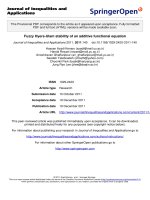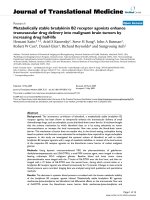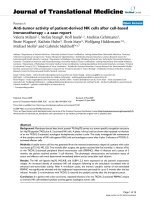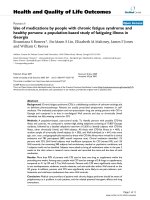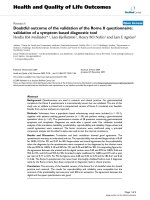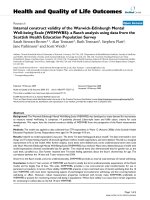Báo cáo hóa học: " Highly stable meso-diaminopimelate dehydrogenase from an Ureibacillus thermosphaericus strain A1 isolated from a Japanese compost: purification, characterization and sequencing" doc
Bạn đang xem bản rút gọn của tài liệu. Xem và tải ngay bản đầy đủ của tài liệu tại đây (2.22 MB, 37 trang )
This Provisional PDF corresponds to the article as it appeared upon acceptance. Fully formatted
PDF and full text (HTML) versions will be made available soon.
Highly stable meso-diaminopimelate dehydrogenase from an Ureibacillus
thermosphaericus strain A1 isolated from a Japanese compost: purification,
characterization and sequencing
AMB Express 2011, 1:43 doi:10.1186/2191-0855-1-43
Hironaga Akita ()
Yasuhiro Fujino ()
Katsumi Doi ()
Toshihisa Ohshima ()
ISSN 2191-0855
Article type Original
Submission date 11 October 2011
Acceptance date 25 November 2011
Publication date 25 November 2011
Article URL />This peer-reviewed article was published immediately upon acceptance. It can be downloaded,
printed and distributed freely for any purposes (see copyright notice below).
Articles in AMB Express are listed in PubMed and archived at PubMed Central.
For information about publishing your research in AMB Express go to
/>For information about other SpringerOpen publications go to
AMB Express
© 2011 Akita et al. ; licensee Springer.
This is an open access article distributed under the terms of the Creative Commons Attribution License ( />which permits unrestricted use, distribution, and reproduction in any medium, provided the original work is properly cited.
Highly stable meso-diaminopimelate dehydrogenase from an Ureibacillus
thermosphaericus strain A1 isolated from a Japanese compost: purification,
characterization and sequencing
Hironaga Akita
1
, Yasuhiro Fujino
2
, Katsumi Doi
3
, Toshihisa Ohshima
3*
1
Applied Molecular Microbiology and Biomass Chemistry, Bioscience and
Biotechnology, Faculty of Agriculture, Kyushu University, 6-10-1 Hakozaki, Higashi-ku,
Fukuoka 812-8581, Japan
2
Center for Research and Advancement in Higer Education, Kyushu University, 744
Motooka, Nishi-ku, Fukuoka 819-0395, Japan
3
Microbial Genetic Division, Institute of Genetic Resources, Faculty of Agriculture
Kyushu University, 6-10-1 Hakozaki, Higashi-ku, Fukuoka 812-8581, Japan
*
Corresponding author:
Email addresses: HA:
YF:
KD:
TO:
Abstract
We screened various thermophiles for meso-diaminopimelate dehydrogenase
(meso-DAPDH, EC 1.4.1.16), which catalyzes the NAD(P)-dependent oxidative
deamination of meso-diaminopimelate, and found the enzyme in a thermophilic
bacterium isolated from compost in Japan. The bacterium grew well aerobically at
around 55°C and was identified as Ureibacillus thermosphaericus strain A1. We
purified the enzyme about 47-fold to homogeneity from crude cell extract using five
successive purification steps. The molecular mass of the purified protein was about 80
kDa, and the molecule consists of a homodimer with the subunit molecular mass of
about 40 kDa. The optimum pH and temperature for the catalytic activity of the
enzyme are about 10.5 and 65°C, respectively. The enzyme is highly selective for
meso-diaminopimelate as the electron donor, and NADP but not NAD can serve as the
electron acceptor. The K
m
values for meso-diaminopimelate and NADP at 50°C and
pH 10.5 are 1.6 mM and 0.13mM, respectively. The nucleotide sequence of this
meso-DAPDH gene encodes a 326-amino acid peptide. When the gene was cloned
and overexpressed in Escherichia coli Rosetta (DE3), the specific activity in the crude
extract of the recombinant cells was about 18.0-fold higher than in the extract from U.
thermosphaericus strain A1. This made more rapid and simpler purification of the
enzyme possible.
Keywords
meso-Diaminopimelate dehydrogenase ・ Ureibacillus thermosphaericus ・
Thermostable amino acid dehydrogenase・Purification and characterization
Introduction
meso-Diaminopimelate dehydrogenase (meso-2,6-D-diaminopimerate dehydrogenase,
meso-DAPDH, EC 1.4.1.16) catalyzes the NADP-dependent oxidative deamination of
meso-2,6-diaminopimelate (meso-DAP) to produce L-2-amino-6-oxopimelate
(L-2-amino-6-oxoheptanedioate). This enzyme is the only known NAD(P)-dependent
dehydrogenase able to stereoselectively act on the D-configuration of meso-DAP. It
has been identified in several bacteria, and is known to function in L-lysine biosynthesis
in Bacillus sphaericus (Misono et al. 1979) and Corynebacterium glutamicum (Misono
et al. 1986a). In addition, it has been purified to homogeneity from B. sphaericus
(Misono and Soda 1980) and Brevibacterium sp. (Misono et al. 1986b), and has been
characterized enzymologically. The meso-DAPDH genes from C. glutamicum (Ishino
et al. 1988) and B. sphaericus (Sakamoto et al. 2001) have been sequenced, and were
found to be highly similar to one another. The C. glutamicum gene has been expressed
in Escherichia coli cells (Reddy et al. 1996), and the three-dimensional structures of the
enzyme-NADP complex (Scapin et al. 1996), the enzyme-substrate complex and an
enzyme-NADP-inhibitor complex (Scapin et al. 1998) have been solved for the C.
glutamicum enzyme and refined to 2.2 Å resolution.
An NADP-dependent, highly stereoselective D-amino acid dehydrogenase was
also prepared through mutation of C. glutamicum meso-DAPDH using both rational and
random mutagenesis (Vedha et al. 2006). The mutant enzyme is potentially useful for
the production of D-amino acids via the reductive amination of the corresponding 2-oxo
acid with ammonia. However, the mutant enzyme is not necessary stable enough to
use for a long term and under various conditions. Thus, more stable meso-DAPDH
and its mutant enzyme have been required. We had looked for the enzyme in
thermophiles by database and the activity analyses, but were not able to find the
homologous gene in sequence to that of C. glutamicum meso-DAPDH in thermophiles.
Thus, we had started the screening of stable meso-DAPDH by detection of the enzyme
activity in many strains of thermophiles stocked as type cultures and isolated from soils
and composts, and found the activity in an aerobically well-grown thermophile from a
compost. Just recently, meso-DAPDH in a thermophilic bacterium, Clostridium
thermocellum was found and the enzymological properties were reported with
emphasizing to show the presence of meso-DAPDH pathway in as well as a succinyl
and acetyl-DAP pathway (Hudson et al, 2011). In the present study, the thermophile of
meso-DAPDH producer isolated from compost was identified to be Ureibacillus
thermosphaericus strain A1. The enzyme was then purified from the thermophile and
characterized as a thermostable meso-DAPDH, and the gene was sequenced.
Materials and methods
Materials
An illustra bacteria genomicPrep Mini Spin Kit was purchased from GE Healthcare
(Buckinghamshire, UK). A HiYield
TM
Plasmid Mini Kit was from
RBC Bioscience
(Taipei, Taiwan). A QIAquick Gel Extraction Kit was from QIAGEN (Hilden,
Germany). Restriction endonucleases were purchased from Takara Bio (Shiga, Japan)
and Toyobo (Osaka, Japan). Butyl Sepharose
TM
4 Fast Flow was from GE Healthcare.
DEAE-Toyopearl M-650 was from Tosoh (Tokyo, Japan). Amicon Ultra-15
was from
Millipore (Billerica, MA, USA). INT
(2-(4-Iodophenyl)-3-(4-nitrophenyl)-5-phenyl-2H-tetrazolium chloride) and 1-Methoxy
PMS (1-Methoxy-5-methylphenazinium methyl sulfate) were from Dojindo
(Kumamoto, Japan). All other chemicals
were reagent grade.
Screening for meso-DAPDH in thermophiles and the growth conditions for U.
thermosphaericus
We isolated thermophiles from a variety of soils, sea sands, composts and mud from hot
springs at 50-70°C using medium containing 0.5% polypeptone-S (Nihonseiyaku,
Tokyo),
0.2% meat extract (Wako Pure Chemical Industries, Osaka), 0.35% NaCl and
2% agar (pH 7.2 with KOH). After cultivation, the cells were collected
by
centrifugation (8,000 × g for 15 min at 4°C), and the terrestrial microorganisms were
washed twice
with 0.85% NaCl, while the marine microorganisms were washed with
3% NaCl. The cells were then suspended with a small amount of 10 mM potassium
phosphate buffer (pH
7.2) containing 10% glycerol and stored at -80°C until used. A
meso-DAPDH producing thermophile, U. thermosphaericus strain A1 was aerobically
cultured over night at 50°C in the liquid medium described above on a reciprocating
rotor (250 rpm). The screening procedure for detection of meso-DAPDH entailed
native polyacrylamide gel electrophoresis (native-PAGE) followed by activity staining
at 50°C with a mixture containing 300 mM potassium phosphate buffer (pH 8.0), 50
mM meso-DAP, 0.1 mM INT, 0.04 mM 1-Methoxy PMS
and 2.5 mM NADP until a red
band of sufficient intensity had developed. Enzyme activity was then assessed
spectrophotometrically as described below in the “Enzyme assay” section.
16S rRNA gene amplification and sequencing
Genomic DNA was extracted from isolated bacteria using an illustra bacteria genomic
Prep Mini Spin Kit and then used as the template for 16S rRNA gene amplification.
DNA fragments were amplified by polymerase chain reaction (PCR) using the universal
primers 27f (5´-AGAGTTTGATCMTGGCTCAG-3´) and 1492r
(5´-TACGGYTACCTTGTTACGACTT-3´). PCR mixture contained 10× Ex Taq
buffer, 0.2 mM dNTP mixture, 100 ng of DNA template, 1.0 µM primers 27f and 1492r,
and 1.25 U of Ex Taq DNA polymerase (Takara Bio) in a final volume of 50 µl. The
PCR protocol entailed a 30s denaturation at 98°C, followed by 30 cycles of 98°C for 30
s, 51°C for 30 s and 72°C for 1.7 min and a final extension at 72°C for 10 min in
TProfessional 96 Gradient (Biometra, Gttingen, Germany). The amplified PCR
products were purified using Wizard® SV Gel and a PCR Clean-up System (Promega,
WI, USA) to remove unconsumed dNTPs and primers and then directly sequenced
using a BigDye® Terminator v3.1 Cycle Sequencing Kit (Applied Biosystems, CA,
USA) on a 3130 Genetic Analyzer.
Phylogenetic analysis of the 16S rRNA gene sequences
The 16S rRNA gene sequences from the bacteria isolated in this study were aligned and
clustered against those of the genus Ureibacillus (Fortina et al 2001), which was
available from GenBank.
Enzyme assay and protein determination
The rate of NADP-dependent oxidative deamination of meso-DAP was
spectrophotometrically determined at 50°C. The standard reaction mixture
(total
volume: 1.00 ml) contained 200 mM carbonate-KOH (pH 10.5),
10 mM meso-DAP,
1.25 mM NADP and enzyme. The mixture without the coenzyme (NADP) was
pre-incubated at 50°C for about 3 min in a cuvette with a 1.0-cm light path. The
reaction was then started by adding 25 mM NADP (50 µl), which had also been
pre-incubated at 50°C. The increase in absorbance accompanied by the formation of
NADPH was monitored at 340 nm (an extinction coefficient = 6.22 mM
-1
cm
-1
). One
unit of enzyme was defined as the amount catalyzing
the formation of 1 µmol of
NADPH/min at 50°C during
meso-DAP oxidation. The protein concentration was
determined by the method of Bradford (1976) using bovine serum albumin as the
standard.
Purification of meso-DAPDH from U. thermosphaericus cells
All steps in the purification procedure were carried out at a room temperature, using 50
mM potassium phosphate buffer (pH 7.2) as the standard buffer. U. thermosphaericus
cells (5.12 g, wet weight) suspended in about 20 ml
of standard buffer were disrupted by
sonication (UD-201; Tomy Seiko,
Tokyo), which entailed five cycles of 60-s pulses (50
W) followed
by a 60-s rest on ice. Thereafter, any remaining intact cells and
the cell
debris were removed by centrifugation (27,500 × g for 20 min at 4°C), and the resultant
supernatant was used as the
crude extract. Ammonium sulfate was added to the crude
extract to 80% saturation, and the precipitate obtained by centrifugation (27,500 × g for
20 min at 4°C) was dissolved in standard buffer supplemented with 1 M (NH
4
)
2
SO
4
.
The resultant solution was then applied to a Butyl Sepharose
TM
4 Fast Flow column (6.1
× 10.0 cm) equilibrated with standard buffer supplemented with 1 M (NH
4
)
2
SO
4
. The
column was then washed with the same supplemented buffer, and the enzyme was
eluted with a linear 1.0 to 0 M (NH
4
)
2
SO
4
gradient in the same buffer. The active
fractions were pooled and dialyzed against the standard buffer, after which the dialyzate
was loaded onto a DEAE-Toyopearl 650M column (6.1 × 5.0 cm) equilibrated
with the
standard buffer. After washing the column with standard buffer, the enzyme was
eluted with a linear 0 to 0.5 M NaCl gradient in the same buffer. The active fractions
were again pooled and dialyzed against the standard buffer, and preparative slab PAGE
was carried out according to the method of Ohshima and Ishida (1992). Finally, the
enzyme was extracted from the gel pieces using the standard buffer and Amicon
Ultra-15, and the resultant enzyme solution was used for experimentation.
PAGE and molecular mass determination
Native-PAGE was carried
out at 4°C on a 7.5% polyacrylamide gel using the method
of
Davis (1964). The protein was then stained using 0.025% Coomassie brilliant blue
R-250 in 50% methanol and 10% acetate. In addition, active staining was performed
at 50°C using a mixture containing 300 mM potassium phosphate buffer (pH 8.0), 50
mM meso-DAP, 0.1 mM INT, 0.04 mM 1-Methoxy PMS
and 1.25 mM NADP until a
red band of sufficient intensity was visible.
Sodium dodecyl sulfate (SDS)-PAGE was carried
out on a 10% polyacrylamide
gel using the method of Laemmli (1970). Precision Plus protein standards (Bio-Rad
Laboratories, CA, USA) were used as the molecular mass standards. The protein
sample was boiled for 5 min in 10 mM Tris-HCl buffer (pH 7.0) containing 1% SDS
and 1% 2-mercaptoethanol. Protein bands were visualized by staining with 0.025%
Coomassie brilliant blue R-250 in 50% methanol and 10% acetate.
The molecular mass of the native enzyme was determined by gel filtration column
chromatography using a Superdex 200 pg column (2.6 × 60 cm). Ferritin (440 kDa),
aldolase (158 kDa), conalbumin (75 kDa), ovalbumin (43 kDa) and
α-chymotrypsinogen (25 kDa) served as molecular standards (GE Healthcare).
Determination of kinetic parameters
The Michaelis constant (K
m
) was determined from double-reciprocal plots of the initial
rate data using meso-DAP as the electron donor and NADP as the electron acceptor at
50°C.
N-Terminal amino acid sequence analysis
The N-terminal amino acid sequence of the isolated enzyme was analyzed using an
automated Edman degradation protein sequencer. The phenylthiohydantoin
derivatives were separated and identified using a Shimadzu PPSQ-10 protein sequencer
(Shimadzu, Kyoto, Japan).
Purification of genomic DNA
To obtain genomic DNA for meso-DAPDH gene sequencing, genomic DNA was
prepared from U. thermosphaericus as follows. U. thermosphaericus cells (about 1 g,
wet weight) were suspended in 10 ml of 50 mM Tris-HCl buffer (pH 8.0) containing 50
mM EDTA, 10 mg of lysozyme per ml and 100 mg of proteinase K (Nacalai Tesque,
Kyoto) per ml, and incubated for 3 h at 37°C. This was followed by addition of 10%
SDS (1.2 ml) and incubation for 15 min at 65°C, after which CTAB-NaCl solution (1.5
ml of 100 mM Tris-HCl (pH 9.0), 10 mM EDTA, 1.4 M NaCl and 2.0%
cetyltrimethylammonium bromide solution) was added, and the cells were incubated for
an additional 15 min at 65°C. The proteins in the mixture were then extracted several
times with phenol-chloroform, and the genomic DNA was precipitated first with 2.5
volumes of 100% ethanol supplemented with 60 µl of 3 M sodium acetate buffer (pH
5.2), and then with 2.5 volumes of 70% ethanol for demineralization. To remove any
contaminating RNA, RNase was then added to the solution and incubated for 3 h at
37°C.
Screening for meso-DAPDH gene
For clonining of the meso-DAPDH gene from U. thermosphaericus, a homology search
was carried out among the related strains using the NCBI BLAST program. Based on
the highly-conserved regions of meso-DAPDH genes, a set of degenerated primers
(forward: 5´-GGRATYGTMGGWTAYGGRAAY-3´ [where M is A or
C; R is A or G;
W is A or T and Y is C or T], reverse: 5´-RACRAAWCCKCCRTGWGG-3´ [where K is
G or
T; R is A or G and W is A or T]) were designed for the partial amplification of
meso-DAPDH gene from U. thermosphaericus. PCR was performed by 30 cycles of
98°C for 30 s, 51°C for 30 s and 72°C for 50 sec with Ex Taq DNA polymerase. The
amplified PCR products were purified and directly sequenced. The complete sequence
of the meso-DAPDH gene was obtained using an in vitro Cloning Kit (Takara Bio)
according to the manufacturer's instructions.
Sequence analysis
The sequence obtained as described above was identified by using the NCBI BLAST
program to run similarity searches against other sequences from available databases.
The sequences were then aligned using ClustalW (Larkin et al. 2007), and multiple
sequence alignment of meso-DAPDHs (Figure 1) was generated.
Expression of meso-DAPDH gene and purification of the gene product
meso-DAPDH gene was amplified using KOD -plus- DNA polymerase (Toyobo) with
primers 5´-CACCATGAGTAAAATTAGAATTGGG-3´
(forward) and
5´-TAAAAGTTCTTTTCTTAAATCTTCTGGAG-3´ (reverse), and then cloned using a
Champion
TM
pET 101 Directional TOPO Expression Kit (invitrogen, CA, USA),
yielding the expression plasmid pET101/DAPDH. E.
coli Rosetta (DE3) cells were
transformed with pET101/DAPDH, after which the transformants were grown in LB
medium (1% Triptone, 1% NaCl and 0.5% yeast extract) containing
0.01% ampicillin at
37°C. After 6 h of cultivation, IPTG (1 mM) was added, and the cultivation was
continued
for an additional 2 h at 37°C. The cells were then collected by
centrifugation (8,000 × g for 15 min at 4°C), resuspended in standard buffer, and
disrupted by sonication as described above. After removing the debris by
centrifugation (27,500 × g for
20 min at 4°C), the supernatant was incubated for 30 min
at 50°C (heat-treatment) and centrifuged (27,500 × g for
20 min at 4°C) again to remove
the unwanted proteins derived from the bacteria. The resultant solution was loaded
onto a Chelating Sepharose
TM
Fast Flow column (6.1 × 6.0 cm) (GE Healthcare)
previously equilibrated with buffer containing 50 mM NiSO
4
, 20 mM Tris-HCl (pH 7.9),
500 mM NaCl and 5 mM imidazole. The column was then washed with washing
buffer (20 mM Tris-HCl (pH 7.9), 500 mM NaCl, 60 mM imidazole), and the adsorbed
proteins were eluted with the elution buffer (20 mM Tris-HCl (pH 7.9), 500 mM NaCl
and 1 M imidazole). The active fractions were pooled and dialyzed
against the
standard buffer.
RESULTS
Screening for meso-DAPDH in thermophiles
When we started this study about 2 years ago, there was no report on meso-DAPDH
from thermophile as the producer of more stable meso-DAPDH. Thus, we screened
more than 100 strains of aerobically grown thermophiles isolated from various soil
samples by incubation at 50°C and 70°C, and detected meso-DAPDH activity in a
thermophile isolated from compost obtained from Munakata City in Fukuoka
Prefecture, Japan. When cultured in liquid medium, the thermophilic strain grew at
temperatures between 37°C and 55°C, but not at 60°C, and maximum growth was
achieved at 50°C. The crude extract from the cells included a high level of
meso-DAPDH activity when NADP served as a coenzyme.
To identify the
thermophile, we
determined the
sequence of the 16S rRNA gene (1425 bp; accession
number: AB671590), which was found to be completely identical to that of U.
thermosphaeicus (accession number: X90640). Thus,
the isolated strain was identified
as U. thermosphaeicus strain A1 and deposited to Biological Resource Center (NBRC),
National Institute of Technology and Evaluation (strain number: NBRC 108682).
Purification of meso-DAPDH from the U. thermosphaeicus
We collected 5.14 g (wet weight) of U. thermosphaeicus cells from
500 ml of culture
medium, and then obtained about 260 mg of soluble protein
from the crude cell extract
after sonication and centrifugation. The purified enzyme was then isolated using
the
five-step procedure described in the materials and methods. The purified
meso-DAPDH migrated as a single band on both native PAGE
(Figure 2A) and
SDS-PAGE (Figure 2B), indicating the enzyme had been purified to homogeneity
(Table 1). At the final step, the enzyme was purified about 47-fold, with an overall
yield of about 4.69%.
Molecular mass and subunit structure
Following native-PAGE, the molecular mass of the U. thermosphaeicus meso-DAPDH
was determined to be about 80 kDa using Superdex 200 pg column gel
filtration
chromatography (data not shown). SDS-PAGE of the enzyme showed one major band
of 40 kDa (Figure 2B), suggesting that the enzyme is composed of two identical
subunits.
Effects of pH, temperature and various chemicals on enzyme activity and stability
The effect of pH on the oxidative deamination of meso-DAP was determined by
assessing the enzyme activity at various pHs. At a temperature of 50°C, the optimum
pH was about 10.5. When the temperature dependence of the catalytic activity at pH
10.5 was examined, maximum activity was observed at around 65°C. Moreover, when
the enzyme was incubated for 30 min at various temperatures in the standard buffer at
pH 7.2, no activity was lost at temperatures below 60°C, while half of the activity was
lost at 65°C (Figure 3). When the effect of pH on the stability of the enzyme was
evaluated based on the activity remaining after incubation at 50°C for 30 min, no loss of
activity was observed at pHs between 5.0 and 11.0 (data not shown).
Substrate and coenzyme specificities
Examination of the substrate specificity of the oxidative deamination of amino acids
revealed that meso-DAP was the only effective substrate in presence of NADP. The
enzyme was highly specific for meso-DAP as the electron donor, and the following
amino acids were inert: DL-2-aminopimelate, D-glutamate, L-glutamate, D-aspartate,
L-aspartate, D-alanine, L-alanine, D-valine, L-valine, D-lysine, L-lysine, D-phenylalanine,
L-phenylalanine, D-leucine, L-leucine, D-threonine, L-threonine, D-serine, L-serine,
D-tryptophan, L-tryptophan, D-cysteine, L-cysteine, D-histidine, L-histidine,
D-methionine, D-arginine, D-proline, D-asparagine, D-glutamine, D-isoleucine and
D-ornithine. Moreover, the enzyme exclusively used NADP as the coenzyme (electron
acceptor) for the oxidative deamination of meso-DAP; NAD was inert.
Inhibitors
The enzyme was completely inhibited by both 0.1 mM p-chloromercuribenzoate and
HgCl
2
, which are typical inhibitors of SH enzymes. Thioglycollate (5 mM), L-cysteine
(5 mM) and Cu
2+
(1 mM) also strongly inhibited the enzyme. Several other metal ions
(1 mM), including Zn
2+
, Co
2+
and Ni
2+
were not inhibitory, nor did 1 mM D-lysine,
L-lysine, EDTA, α,α’-dipyridyl, NaN
3
or iodoacetic acid affect the oxidative
deamination of meso-DAP.
Kinetic studies
Analysis of the initial velocity of the oxidative deamination of meso-DAP in the
presence of NADP yielded typical Michaelis-Menten kinetics. As determined from
Lineweaver-Burk plots, the apparent K
m
values at 50°C in cabonate-KOH buffer (pH
10.5) were 1.6 mM and 0.13 mM for meso-DAP and NADP, respectively.
N-Terminal amino acid sequencing
Using an automated Edman degradation protein sequencer, the N-terminal amino acid
sequence of the subunit was determined to be SKIRIGIVGY.
Gene sequencing
To identify the meso-DAPDH gene in the chromosome of U. thermosphaeicus, in vitro
cloning
was performed as described in materials and methods with information of
N-terminal amino acid sequence. Sequencing of the fragment revealed a single 981-bp
open reading frame encoding 326 amino acids (accession number: AB636161), and the
deduced N-terminal amino acid sequence was identical to that obtained by protein
sequencing. An NCBI BLAST search revealed the amino acid sequence of U.
thermosphaeicus meso-DAPDH to be highly homologous with the sequence of
meso-DAPDH from B. sphaericus (80%), Bacillus sp. B14905 (79%), Cl. thermocellum
ATC
C 27405 (64%) and with those from the putative meso-DAPDHs from
Lysinibacillus fusiformis ZC1 (80%), L. sphaericus C3-41 (80%), Cl. tetani E88 (66%)
and Herminiimonas arsenicoxydans (66%).
Purification and characterization of recombinant meso-DAPDH expressed in E.
coli
After transformation of E. coli Rosetta (DE3) cells with pET101/DAPDH,
which
harbored the recombinant meso-DAPDH gene, a high level of meso-DAPDH
production
was found in the crude extract of the transformants. The recombinant meso-DAPDH
was easily purified about 2.4-fold, with an overall yield of about 53.1%, by successive
heat-treatment and Chelating Sepharose Fast Flow column chromatography
steps.
With this procedure, we obtained 54.6 mg of the purified protein from 2.38 g (wet
weight) of E. coli cells (Table 2).
The maximum activity of the purified recombinant meso-DAPDH was detected at
65°C in carbonate-KOH buffer at pH 10.5. Full activity was retained after incubation
at 60°C for 30 min, but activity was completely
lost after incubation at 70°C for 30 min.
There was no significant difference in the enzyme stability or the molecular mass
between the purified native meso-DAPDH and the purified recombinant meso-DAPDH.
Discussion
Misono et al. (1979; 1986a) previously described the relatively wide distribution of
meso-DAPDHs among mesophilic bacteria, including B. sphaericus, Brevibacterium sp.,
C. glutamicum and Proteus vulgaris. The presence of meso-DAPDH in thermophile
has not been found until the recent report on the enzyme from an anerobic Cl.
thermocellum (Hudson et al. 2011). We found one enzyme producer in many aerobic
thermophiles by extensive screening. The thermophile was identicafied to be U.
thermosphaeicus strain A1. This is the first producer of meso-DAPDH in aerobic
thermophile.
As expected, meso-DAPDH purified from U. thermosphaericus is much more
thermostable than its counterparts from mesophiles, such as B. sphaericus (Misono and
Soda 1980) and C. glutamicum (Misono et al 1986a): the U. thermosphaericus enzyme
showed almost no loss of activity after incubation for 30 min at temperatures up to 60°C,
whereas the mesophilic enzymes lost their activity within 10 min at temperatures above
48°C. There is no report with respect to the thermostability of the Cl. thermocellum
enzyme (Hudson et al. 2011). In addition, the U. thermosphaericus enzyme is highly
stable over wider range of pHs (no loss of activity at pH 5.0 to 11.0 after incubation for
